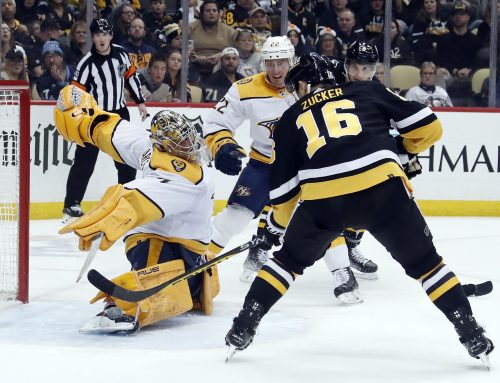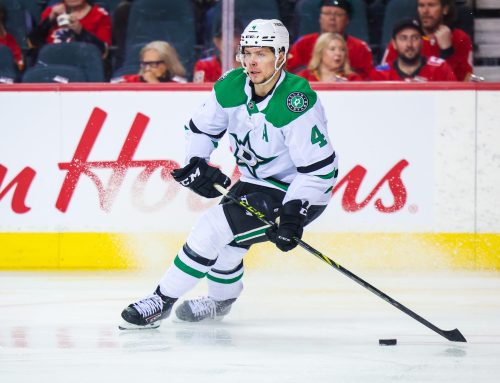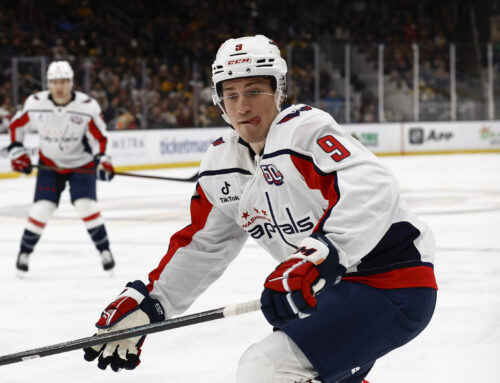
Which forwards were the best bang for the buck this season?
The NHL playoffs are well underway and for many of you so is the offseason in your keeper league. At this time while you’re not enjoying the intense hockey on TV you are thinking about your roster. You may be trimming your roster for a keeper re-draft or you may be thinking ahead to the prospect draft. In salary cap leagues the summer will throw a bunch of curve balls in your direction and can often leave you with a financially illegal roster in no time.
Beyond your own team, the free agent signing period brings a ton of change to player fantasy value across the league. What used to be a cheap bargain depth player filling your final roster spot admirably can become a more fairly-paid player that is simply too rich to fit on your squad. By the time your hand is being forced, that player’s value on the trade market has also changed.
Using Capgeek’s Bargain Hunter tool, we will look back at the most cost-effective forwards of this season as well as the most productive players on this list of cheap scorers. From these lists we can draw conclusions based on which players are currently there to figure out how to best go about finding a replacement for your departing former player.
Note: Under the Years Left (YRL) column “X” signifies that the player already signed a contract extension while “R” means that the player is a restricted free agent this summer.
Best Bang For The Buck
|
Name |
Pos |
Team |
GP |
G |
A |
P |
ATOI |
CAP HIT |
VALUE |
YRL |
|
F |
81 |
23 |
36 |
59 |
18.03 |
$579,167 |
$9,816 |
R |
||
|
F |
77 |
22 |
27 |
49 |
16.23 |
$700,000 |
$14,286 |
X |
||
|
F |
80 |
20 |
19 |
39 |
15.69 |
$577,500 |
$14,808 |
X |
||
|
F |
82 |
20 |
31 |
51 |
14.71 |
$900,000 |
$17,647 |
R |
||
|
F |
81 |
16 |
15 |
31 |
16.4 |
$550,000 |
$17,742 |
R |
||
|
F |
75 |
17 |
15 |
32 |
13.06 |
$575,000 |
$17,969 |
X |
||
|
F |
82 |
24 |
26 |
50 |
18.78 |
$900,000 |
$18,000 |
1 |
||
|
F |
81 |
16 |
19 |
35 |
17.33 |
$637,778 |
$18,222 |
R |
||
|
F |
78 |
19 |
28 |
47 |
16.29 |
$894,167 |
$19,025 |
1 |
||
|
F |
77 |
19 |
40 |
59 |
17.14 |
$1,150,000 |
$19,492 |
R |
Here, the contract extensions are interesting. While Bonino ($1.9 million) received a raise that almost triples his cap hit, his dollar-per-point value of $38,775 under his new contract would still rank within the top-100 of the league. Meanwhile, the deals signed by Shaw and Garbutt do not offer the same value as their lack of offense limits their usefulness to deeper leagues anyway. Still, in those leagues they remain decent alternative options if you need help to fill out your roster.
Even more interesting is the fact that there are no players in this list heading for unrestricted free agency this summer. All of these players are either on cheap entry-level contracts or past their first contract but still at a young stage in their careers. Also, not one of the 10 forwards listed here are first-round picks.
Most Productive Cap Bargains
|
Name |
Pos |
Team |
GP |
G |
A |
P
📢 advertisement:
|
ATOI |
CAP HIT |
VALUE |
YRL |
|
F |
82 |
28 |
58 |
86 |
20.43 |
$3,750,000 |
$43,605 |
X |
||
|
F |
82 |
41 |
38 |
79 |
19.85 |
$4,000,000 |
$50,633 |
X |
||
|
F |
71 |
23 |
47 |
70 |
18.5 |
$3,500,000 |
$50,000 |
X |
||
|
F |
71 |
27 |
42 |
69 |
20.43 |
$2,800,000 |
$40,580 |
2 |
||
|
F |
82 |
33 |
30 |
63 |
17.65 |
$1,945,000 |
$30,873 |
R |
||
|
F |
81 |
23 |
36 |
59 |
18.03 |
$579,167 |
$9,816 |
R |
||
|
F |
77 |
19 |
40 |
59 |
17.14 |
$1,150,000 |
$19,492 |
R |
||
|
F |
80 |
25 |
33 |
58 |
18.34 |
$2,750,000 |
$47,414 |
2 |
||
|
F |
80 |
25 |
31 |
56 |
17.53 |
$1,166,667 |
$20,833 |
R |
||
|
F |
79 |
24 |
28 |
52 |
16.4 |
$2,000,000 |
$38,462 |
1 |
Obviously, the trio of Giroux, Pavelski and Duchene really stands out here. Each of them has already received a large contract extension that will obviously take them out of cap bargain territory when simply evaluating money versus points. But, as star players, they are certainly worth the money due to how much they produce from a single roster position. Being able to acquire cap bargain players to fill out depth positions will help absorb your larger contracts.
Next, there are a pair of rare contracts belonging to Islanders that run for two more years. Both have a history of decent production before hitting career-highs this year. Normally, when this happens there is usually a contract renewal (and often times a big raise) right around the corner. Thankfully, that is not the case here. Both players are excellent investments moving forward. Even if they regress a bit, the numbers are still very good and the price is very budget-friendly.
Finally, this list also does not possess any pending unrestricted free agents. This is once again a very young group. Both Pavelski and Nielsen will turn 30 soon while everyone else is 26 or younger.
Young Cap Bargains
The theme of the forward groups is youth. Looking at the bargain hunter list, the majority of players listed are still very early in their careers. A lot of them are simply overachievers that succeeded beyond expectations. As such, their smaller contracts make them important assets in cap leagues.
Due to their age, the majority become restricted free agents instead of unrestricted. There are two benefits to this status. First, there is a chance that your player signs a bridge contract much like the ones signed by Nazem Kadri and PK Subban. Also, having negotiations (usually) kept in-house prevents your player from being exposed to the madness of unrestricted free agency where ugly contracts such as the agreement signed by David Clarkson can put you in a tough position.
Prospect Draft
The best way to obtain new young talent is via your league’s prospect draft. A lot of poolies think of the draft as the vehicle to turn their rebuilds into success stories but this is also an essential part in maintaining a top team in a salary cap league. If your league has farm team slots then you can use them to put players away while they develop.
The bottom line is that you have to take advantage of the draft picks that you possess. The early picks are easier to make and their entry-level contracts will typically be larger so the later picks become very important as a tool to obtain future productive players that carry a cost close to the league minimum.
It is up to you to figure out a prospect development system that makes the most sense within your league’s settings. The amount of farm positions you have, your career GP restrictions for farm eligibility, limitations on waiver wire moves per year, etc. will have a great impact on which prospects should be targeted and which ones are a waste of time.
Also, you should look into undrafted free agents, which primarily come from college hockey and from Europe. The bust potential is there but many of them possess a similar upside to their 18-year-old counterparts and if they pan out the return on investment is much quicker. This is also a great place to target goalie prospects if you want to bypass the absurd development time.
For more on targeting new salary cap bargains, check out a two-part series (Part 1 and Part 2) that goes over finding new candidates for a variety of league scoring formats.
Next week we will go over this year’s cap bargain defensemen who are always more difficult to dissect than forwards.
Find me on Twitter @DH_EricDaoust.





 FLA
FLA EDM
EDM MIN
MIN DAL
DAL UTA
UTA VAN
VAN STL
STL TOR
TOR L.A
L.A COL
COL
